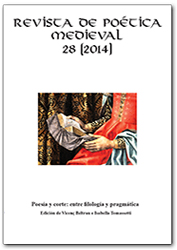«La Nave de la iglesia de Bernardo de Toro y el Bajel de la Magdalena de Luis de Alcázar: recepción a lo divino de motivos clásicos en el Cancionero sevillano de Fuenmayor (siglos XVI-XVII)»
DOI:
https://doi.org/10.37536/RPM.2014.28.0.53214Resumen
Resumen: La lírica a lo divino constituye un género que se desarrolla poderosamente a partir del siglo XV, según una técnica de reescritura que culmina en la poesía de los grandes místicos del Renacimiento español. El Cancionero de Fuenmayor, códice sevillano de poesía religiosa de finales del siglo XVI, presenta un abundante caudal de vueltas a lo divino de temas, motivos, metáforas e imágenes poéticas propios de la poesía profana, como heridas, prisiones, fuentes y cazas de amor. En el presente estudio se analiza uno de los iconos más visitados por los autores del Fuenmayor, el motivo de la descriptio tempestatis, con las alegorías de la nave de la iglesia y del bajel o caravela de la Magdalena.
Palabras clave: Cancionero Fuenmayor. Bernardo de Toro. Luis Alcázar. Nave de la Iglesia. Bajel de la Magdalena. Reescritura a lo divino.
Abstract: The adaptation a lo divino of secular topics (themes, metaphors, motifs, images) is most popular during the 16th and 17th centuries, the Golden Age of Spanish literature. The Cancionero of Fuenmayor is a manuscript of religious poetry of the end of 16th century, that includes an important number of contrafacta a lo divino. In this article I analize one of the most utilized topic from Fuenmayor’s authors: the descriptio tempestatis, with allegory of the Ship of Church and of the vessel of the Magdalena.
Keywords: Cancionero Fuenmayor. Bernardo de Toro. Luis Alcázar. Ship of Church. Vessel of the Magdalena. Adaptation a lo divino.
Descargas
Métricas alternativas
Descargas
Cómo citar
Número
Sección
Licencia
Las opiniones y hechos consignados en cada artículo son de exclusiva responsabilidad de sus autores. La Universidad de Alcalá no se hace responsable, en ningún caso, de la credibilidad y autenticidad de los trabajos.
Los autores conservan los derechos sobre sus trabajos, aunque ceden de forma no exclusiva los derechos de explotación (reproducción, edición, distribución, comunicación pública y exhibición) a la revista. Los autores son, por lo tanto, libres de hacer acuerdos contractuales adicionales independientes para la distribución no exclusiva de la versión de la obra publicada en la revista (por ejemplo, alojarlo en un repositorio institucional o publicarlo en un libro), siempre que medie un reconocimiento de su publicación inicial en esta revista.
Los trabajos se publican bajo los términos estipulados en la Licencia de Atribución-NoComercial-CompartirIgual 4.0 Internacional Creative Commons (CC BY-NC-SA 4.0) que permite a terceros compartir la obra bajo las siguientes condiciones:
Atribución — Usted debe dar crédito de manera adecuada, brindar un enlace a la licencia, e indicar si se han realizado cambios. Puede hacerlo en cualquier forma razonable, pero no de forma tal que sugiera que usted o su uso tienen el apoyo de la licenciante.
NoComercial — Usted no puede hacer uso del material con propósitos comerciales.
CompartirIgual — Si remezcla, transforma o crea a partir del material, debe distribuir su contribución bajo la misma licencia del original.










